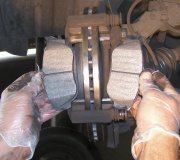Typically they go to the rear so a point on the rotating rotor hits that "squeaker" first, then it runs under the pad, but that is not always the case. There are a few calipers that you cannot install the pad on the wrong side because the wear indicator interferes, but on most calipers either pad will fit on either side.
Here is a guide to help you see what you are in for when doing the job:
https://www.2carpros.com/articles/how-to-replace-front-brake-pads-and-rotors-fwd
If you compare a wear indicator to running your fingertips down a blackboard, due to the shape of those indicators, when they are at the rear of the pad and they make contact with the rotor, they will tend to bend and hit the rotor harder, like curling your fingertips so your fingernails screech on the blackboard. If the indicator is on the front of the pad, and it hits the rotor, friction will tend to bend it so it puts less pressure on the rotor and squeals less or not at all. That would defeat its purpose. This would be like dragging your fingers down the blackboard, but you let them relax and bend straight so it is your finger prints that rub on the board, not your hard nails.
To save on manufacturing costs, a lot of manufacturers only cast one caliper for a certain car model, then they drill two holes in them, one for the hose and one for the bleeder screw. They switch where each hole is to make a caliper work on the other side of the car. As a side note, either caliper can be mounted on either side of the car, but the bleeder screw will be at the bottom and ineffective if the caliper is put on the wrong side. Since both calipers are identical in all other ways, it stands to reason either outer pad can be attached to them. With Chrysler's mounting assemblies on their older cars, the wear indicator would hit the bracket if the wrong pad was installed, so you had no choice but to get it right. You could switch calipers on a lot of Fords too, but most of them did not have wear indicators to interfere.
The bottom line is you want the wear indicators to be out in the open so you will hear them. They should not end up buried under a mounting bracket.
We run into cars all the time we never worked on before. Standard procedure is to disassemble just one side at a time so we can look at the other side for reference if we have to. Then, just pick the new pad that matches the old one you removed.
SPONSORED LINKS
Monday, March 29th, 2021 AT 12:27 PM





